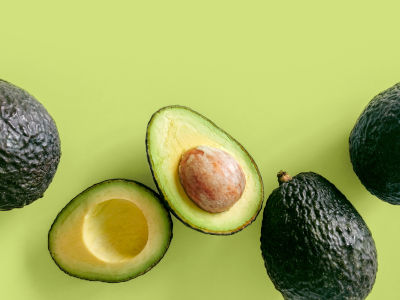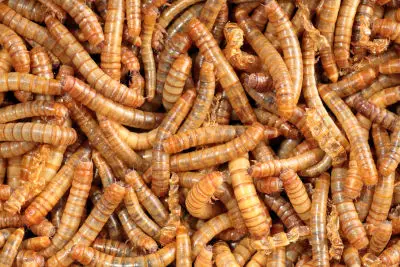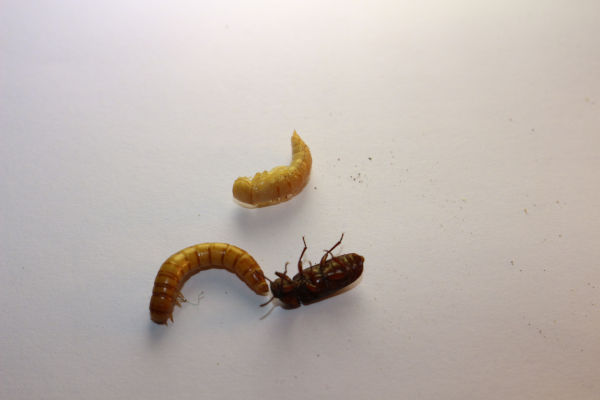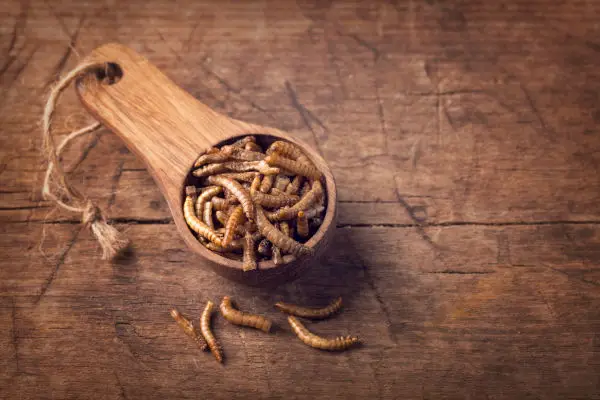Can Bearded Dragons Eat Mealworm Pupa? (Is it Safe?)
If you are concerned about what to feed your Beardie (Click here, to learn from this guide, if you are slowly torturing your Beardie with the wrong foods), you may be wondering if mealworm pupa is risky or not.
Can bearded dragons eat mealworm pupa? Yes, Bearded Dragons can eat Mealworm Pupa, but they have high-fat content, may cause impaction, and have a tough outer shell, which is no ideal for baby Beardies. So, at best, they would be regarded as a treat.
| Are these foods dangerous for your Beardie? | |
| Avacado? Click here to learn, from this guide, if this food is dangerous |  |
| Superworms? Click here to learn, from this guide, if this food is dangerous |  |
Now that you know that Mealworm pupa is ok in moderation, but need some caution. Keep reading to learn how they become Pupa, how you can reduce costs by breeding your own, other risks, and much more.
What is mealworm pupa?

Mealworm Pupa, Larvae & Adult Darkling Beetle
Before we look any further into the viability of mealworm pupae being a food source for your Beardie, let me explain exactly what one is. There is often some confusion between their larval stage and pupae, so let me clarify.
In General
In a nutshell, a mealworm pupa is Darkling Beetle (Click here to see if your Beardie can eat Beetles) that is in its last transitions stage. To fully understand this you need to learn all the stages that they go through before they get to be a beetle. Therefore, in the next section I will explain.
A mealworms lifecycle
As I discussed earlier, in this section I will explain the lifecycle that these mealworms go through to get to the Pupae stage, followed bu the ultimate goal, a darling beetle.
Eggs
The first stage is being an egg. They are laid by their mother and many eggs are laid. To put this into perspective, each egg is really small. No, really really small. Like, s spec of dust small, are you with me These eggs are usually hidden in dirt or some substrate.
Larva
Once the mealworm passes the egg stage, which is usually up to four weeks, they will become larvae. This is the longest stage and can take up to 8 weeks.
At this stage they eat a lot and grow fast. They start off as a minute thing and soon grow up to an inch or so in length. At this stage is when mealworms are common live food for lizards.
Their goal at this stage is to eat, grow, and prepare for their next stage, Pupae.
Pupa
At this Pupae stage mealworms don’t really do much. Yes, they have wing buds and legs, but they are not really functional at this stage. They stay at this stage for a few weeks before becoming a beetle.
Adult (Beetle)
Finally, after many weeks, they will go through metamorphosis and become a beetle. Like us humans, the whole cycle goes round and round breeding many many mealworms. In the next section you will see how this is beneficial for Bearded Dragon owners.
Are there any benefits of mealworm pupa?
As I hinted earlier, there is one main benefit of mealworm Pupae. In this section I will explain how this can be realized.
Breeding fast
These mealworms breed fast. And, because they are a potential food source for your Beardie, you can use this to your advantage. You can effectively breed your own lizard food to cut back on the cost.
However, as you may expect, there are some costs and challenges with this. But, in comparison to other insects, they have basic needs.
They do need the correct temperature and humidity to breed. The humidity is key, later I will explain how this can work adversely, in certain situations.
Are there any known risks?
Like most things, where there are benefits, there will be some risks. For that reason, in this section I will explain what some of these risks are so you know.
Some say they are not a good food source
There are some Bearded Dragon owners that say that mealworm pupa is not a good option. They suggest Superworms are better. This is because of their tough outer shell that can cause some difficulties. However, its an ongoing debate, with arguments on both sides.
Giant Mealworms may not breed
There are some mealworm variations called giant mealworms, these mealworms are known to be fed growth hormones to get their size. This process also prevents them from turning into beetles. Another problem with this is breeding. If you plan to breed them, to save costs, you will struggle, because of these growth hormones.
High-fat content
One other issue with mealworm pupae is their fat content. The chances are your Beardie will love them. But, you should restrict the amount he eats to control his weight and avoid obesity.
Impaction
Impaction is when your lizard’s bowels are obstructed. Which is one of the concerns with Mealworms, and more so with the pupae. Some owners swear by them, others claim they can cause impaction because of their hard outer shell.
Should your Bearded Dragon be eating mealworm pupa?
Now that you know the risks and benefits you may be wondering if it is a good idea to feed your Beardie mealworm pupae, right?
Yes, it is ok to feed your Bearded Dragon mealworm pupa. But, some caution is need because they do have high-fat content, and some say they can cause impaction, as discussed earlier, so they should not be feed regular, more of a treat.
What about baby Beardies, should they eat it?
Now that you know they are ok for Adult Beardies, you may be wondering if the same rule applies for babies, right?
No, I would not advise feeding a baby Beardie mealworm pupae. This is because of their hard outer shell and baby Beardies are more fragile.
Can you freeze mealworms?

Edible mealworms in a wooden spoon
In this section I will explain if freezing mealworms is possible. Also, some alternative measures that you can use to get around some of the problems that it presents.
Yes, you can freeze mealworms. However, it’s not a good idea. This is because the mealworms will die if you do this. The temperature is way too low for them, are you with me?
Refrigerating them instead
Instead of freezing them you can consider refrigerating them. This is beneficial because of these reasons:
- They will stay alive
- Go into hibernation
Not only will they stay alive they will go into hibernation. This hibernation will stop them from transitioning into beetles and allow you to store them. This can be a good way to stop the waste, or buying them in bulk and storing them, rather than leaving it until the last minute to get more, are you with me?
Can freeze-dried mealworms come back to life?
In the last section I explained about the effects of freezing mealworms, but what about freeze-dried mealworms that you buy, can they come back to life?
No, freeze-dried mealworms cannot come back to life. As discussed earlier, if they are refrigerated and in hibernation, yes, that is possible, but not when they are freeze-dried.
At what temperature do mealworms die?
Now that you know that they won’t survive when frozen or freeze-dried, what temperature is too much? or what temperature is optimal for them?
Ideally you need to keep mealworms at 70 degrees Fahrenheit. However, they will eat a lot and transition to beetles fast at this temperature. Which, is what is intended by nature. But, if you want to store them as worms, you need to consider refrigerating them.
Related Questions:
In this section, I will answer some questions related to Bearded Dragon food and other behavior issues. If you have any other questions feel free to contact me.
Q: Can Bearded Dragons catch flying insects?
Yes, Bearded Dragons can catch insects such as crickets. But they are not truly flying insects like a moth (Click here to see if your Beardie can eat this). This is because they are not really built to capture them. Other lizards, like chameleons, have large tongues to catch flies, etc.